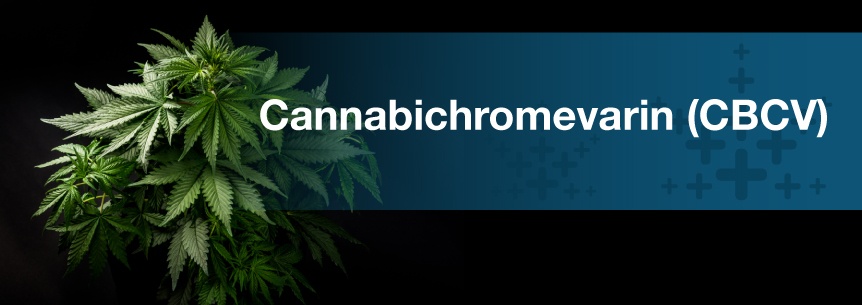
The marijuana plant contains many different cannabinoid acids, which turn to cannabinoid compounds after activation, often by heat. Tetrahydrocannabinol (THC) and cannabidiol (CBD) may be the most well-known, but the plant also yields various other compounds that may have medicinal benefits. Researchers aren’t sure exactly how many compounds there are, but studies suggest there may be more than 100. Each cannabinoid has a unique effect and, so, can be used to treat different medical conditions.
One of these lesser-known but powerful cannabinoids is cannabichromevarin (CBCV).
We have known about CBCV since 1975 when researchers at the University of Nagasaki in Thailand isolated it from a cannabis plant. However, scientists haven’t conducted much research on the compound since its discovery.
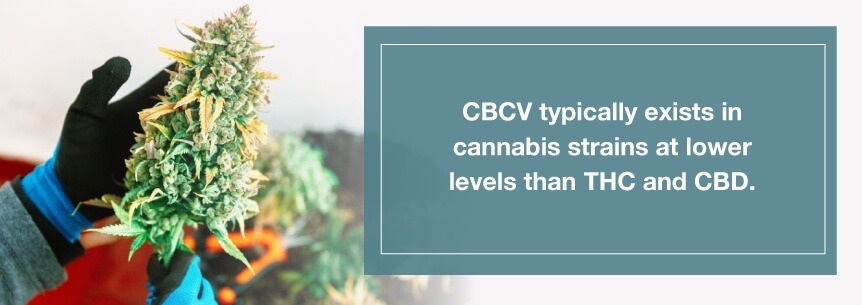
CBCV typically exists in cannabis strains at lower levels than THC and CBD. It’s related to cannabichromene (CBC), another cannabinoid that appears in smaller amounts than the two main ones. Compared to CBC, CBCV has a similar but shorter chemical structure. It is a propyl cannabinoid, which means it has a propyl chain in its molecular structure. So, rather than its counterpart, which has a pentyl chain, it branches off once again to include a propyl chain. CBCV has the molecular formula C19H26O2.
Because scientists have been restricted in the amount of research they’ve been able to conduct into CBCV — along with marijuana in general — we don’t have a lot of information on its unique qualities. We do have some knowledge, though, that we can use to make predictions about how it reacts with the human body. However, CBCV could have some unique and valuable properties we should still take the time to discover and study.
Because CBCV and CBC have similar molecular structures, they may also have similar effects. There could, however, also be some significant differentiators. Propyl cannabinoids — in this case, CBCV — often work similarly to their counterparts, CBC in this situation. Yet, some have unique effects that you can’t find in any other cannabinoids.
Two notable examples of the ways a propyl chain can affect a cannabinoid’s properties are THCV and CBDV. CBDV and CBD have nearly identical effects, with CBDV specializing in specific health benefits. But, THCV can enhance or dampen the effects of THC, as well as act as an appetite suppressant instead of a stimulant. So, for all we know, CBCV could have unique potential — we just haven’t discovered it yet.
It’s hard to say precisely what makes CBCV unique from other cannabinoids aside from its molecular structure because of the lack of research on the topic. As mentioned earlier, some compounds with similar structures act similarly, while others demonstrate unique characteristics.
For example, THC and CBD, the two most common compounds in cannabis, have very different effects. THC is psychoactive and produces the “high” that many people use marijuana for. Meanwhile, CBD is non-psychoactive and can even counteract the cognitive impacts of THC. CBD is the compound sought after for many of marijuana’s medical uses. Because of this, research into CBD has developed faster, and CBD is also more likely to be legal.
The stark differences between THC and CBD illustrate how different cannabinoids can be from each other. Because of these differences, some advocate a “whole plant” approach. Proponents of this approach believe the varying effects balance of a plant’s cannabinoids balance each other out and help substances derive from the plant perform better overall.
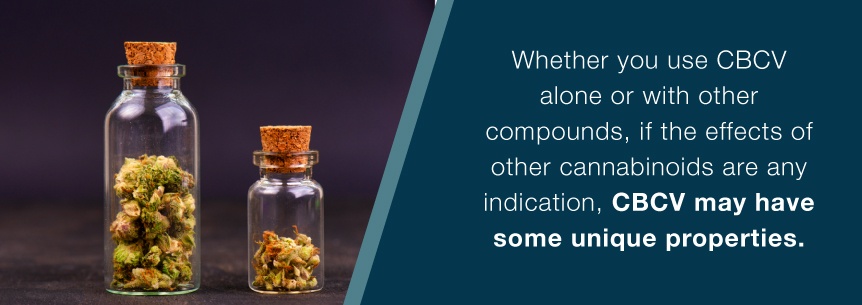
Whether you use CBCV alone or with other compounds, if the effects of other cannabinoids are any indication, CBCV may have some unique properties.
As we mentioned before, researchers don’t know much about CBCV and its impact on the human body. However, we can make some educated guesses about its medical potential.
CBC is believed to be a powerful anandamide (AEA) reuptake inhibitor. It has also been shown to be an anti-inflammatory, antidepressant, antibiotic, analgesic and antifungal.
If CBCV turns out to have similar medical benefits to CBC, it could help patients without making them feel impaired, similar to CBD. CBC doesn’t have any psychoactive properties, so it doesn’t cause a “high” or other mental effects. But, it can still relieve pain, reduce inflammation and improve depression symptoms. In the case that CBCV provides similar benefits to those CBC delivers, it could make these results even stronger.
Some researchers also believe that all of the cannabinoids in a strain work together to make the substance work more effectively. If this turns out to be true, CBCV could play an essential role in helping other compounds have the most impact.
Assuming CBCV has similar medical properties to CBC, it could help patients who have a range of health issues without causing intoxication. CBCV may be beneficial for patients with conditions such as:
One particular area of interest regarding CBCV is its applications for relieving seizures in children and infants. Researchers from the Regents of the University of California have a patent on an anticonvulsant drug for infants dealing with seizures. While the medicine mainly contains cannabidiol (CBD), the patent mentions CBC and CBCV as potential components. The license doesn’t prove CBCV can relieve seizures, but it proves researchers have enough data to express interest in its possible anticonvulsant properties.
As mentioned earlier, CBCV doesn’t have psychoactive effects like THC does, so the side effects likely would not be as pronounced as those of THC.
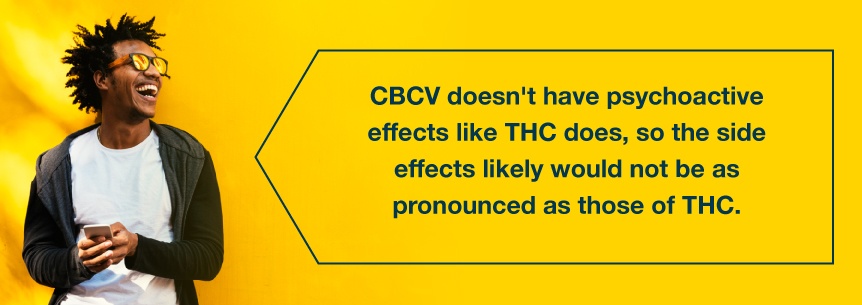
Some users of compounds similar to CBCV have reported side effects that include drowsiness, lightheadedness, dry mouth and lowered blood pressure. Some of these same side effects might also occur when using CBCV. It may not be safe to drive or operate machinery after taking high amounts of CBCV, either.
Marijuana is generally regarded as a safe treatment for most patients, provided they follow doctors’ instructions. Research has not found any significant side effects, aside from the psychoactive effects of THC.
Smoking, however, can always have negative impacts on the respiratory system. This is why most medical marijuana users use an oil, spray, vaporizer or another method that doesn’t involve smoking.
Although cannabinoids are regarded as safe, as a precaution, you may want to avoid them if you’re breastfeeding or pregnant since there hasn’t yet been much research on this topic — especially in regards to CBCV. Those with Parkinson’s disease should also take extra care, as high doses of CBD have been found to worsen symptoms in some people.
You should always consult a doctor before starting CBCV or any other new form of treatment.
No matter what method you use to take medical marijuana, it affects you because of its interaction with the receptors in your body’s endogenous cannabinoids system, or endocannabinoid system (ECS).
All cannabinoids, including CBCV, interact with your body this way. This system provides highly specific chemical mechanisms that enable cannabinoids to have the effects they do. The human body even makes cannabinoids of its own, called endocannabinoids.
ECS receptors exist all throughout the body. We that we have them in our brains, eyes, reproductive systems and immune systems, but we likely have them in other places, as well. Scientists still need to conduct more research into the endocannabinoid system to find out how many receptors we have and fully understand how the system works.
When ingested, smoked, vaporized or otherwise used, cannabinoids bind to these receptors and create the effects of the particular compound, whether they’re psychoactive or medicinal.
You could likely use CBCV the same way medical marijuana patients use other cannabinoids. A variety of methods exist, and the best one for you depends on your condition and personal preferences. A doctor can help advise you as to the right approach for your needs.
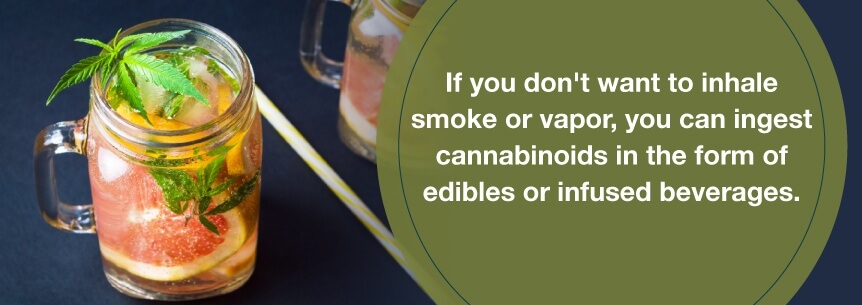
The most popular methods of ingestion include:
No laws specific to CBCV itself exist yet, but there are, of course, many regarding marijuana, THC and CBD. All forms of weed and cannabinoids are still illegal under federal law, but in many states, they are now legal for medical use with a doctor’s prescription. In some states, marijuana is even legal for recreational use. Although CBCV is not psychoactive, it’s still illegal under federal law and in states that do not have a legal cannabis program yet.
The legality of marijuana, even for medical use, is tricky due to contradictions between federal and state laws. The Rohrabacher-Farr amendment makes the issue slightly less confusing by restricting the Justice Department and Drug Enforcement Agency from disregarding state medical cannabis laws. Because of this amendment, although the DEA considers even cannabidiol (CBD) illegal, you can still use medical marijuana in your state if:
To make sure you stay on the right side of the law, take the time to understand relevant federal, state and local laws and how they might impact you. You should also have a doctor you trust, a medical marijuana provider you trust, a valid medical marijuana card and an updated prescription.
Cannabichromevarin (CBCV), like so many other cannabinoids, is a promising possibility for medical treatment, but we still need to conduct substantial amounts of research before we can fully understand what it’s capable of. As laws are changing, medical marijuana research is expanding and more people are realizing the potential benefits of cannabis, the pace of progress in this area is quickening. Perhaps we will soon know more about CBCV and its potential medical benefits.
To keep track of the latest developments in medical marijuana research, read our blog updates or sign up for our newsletter. We always make sure to update our readers as soon as possible of the latest scientific, medical and legal breakthroughs related to medical marijuana. We also provide a variety of other resources on our site, including tools to help you find reliable, compassionate doctors and dispensaries near you.